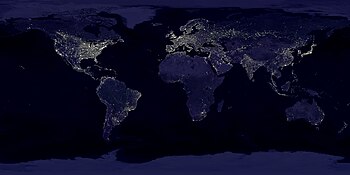बहनि
| थ्व च्वसुयात अंग्रेजी नं नेपालभाषाय् अनुवाद याये मानि। थ्व च्वसुइत नेपालभाषाय् अनुवाद याना ग्वहालि यानादिसँ। |

बहनि धाःगु सूर्द्य क्षितिज स्वया क्वय् दूगु दिंया कालखन्द ख। न्हि व बहनि जाना दिं दइ। छन्हुइ २४ घौ दइ व मौसम, अक्षांश, भूगोल आदिया आधारय् बहनिया ई म्हो वा अप्व जुइ।
Duration and geography
[सम्पादन]Nights are shorter than days on average due to two factors. One, the sun is not a point, but has an apparent size of about 32 minutes of arc. Two, the atmosphere refracts sunlight so that some of it reaches the ground when the sun is below the horizon by about 34 minutes of arc. The combination of these two factors means that light reaches the ground when the centre of the sun is below the horizon by about 50 minutes of arc.
Without these effects, day and night would be the same length at the autumnal (autumn/fall) and vernal (spring) equinoxes, the moments when the sun passes over the equator. In reality, around the equinoxes the day is almost 14 minutes longer than the night at the equator, and even more closer to the poles. The summer and winter solstices mark the shortest night and the longest night, respectively.
The closer a location is to the North or South Pole, the larger the range of variation in the night's length. Although equinoxes occur with a day and night close to equal length, before and after an equinox the ratio of night to day changes more rapidly in locations near the poles than in locations between the Tropic of Cancer and the Tropic of Capricorn. In the Northern Hemisphere, Denmark has shorter nights in June than India has. In the Southern Hemisphere, Antarctica has longer nights in June than Chile has. The Northern and Southern Hemispheres of the world experience the same patterns of night length at the same latitudes, but the cycles are 6 months apart so that one hemisphere experiences long nights (winter) while the other is experiencing short nights (summer).
Between the pole and the polar circle, the variation in daylight hours is so extreme that for a portion of the summer, there is no longer an intervening night between consecutive days and in the winter there is a period that there is no intervening day between consecutive nights.
On other celestial bodies
[सम्पादन]The phenomenon of day and night is due to the rotation of a celestial body about its axis, creating the illusion of the sun rising and setting. Different bodies spin at very different rates, however. Some may spin much faster than Earth, while others spin extremely slowly, leading to very long days and nights. The planet Venus rotates once every 224.7 days – by far the slowest rotation period of any of the major planets. In contrast, the gas giant Jupiter's sidereal day is only 9 hours and 56 minutes.[१] A planet may experience large temperature variations between day and night, such as Mercury, the closest planet to the sun. This is one consideration in terms of planetary habitability or the possibility of extraterrestrial life.
Impact on life
[सम्पादन]
| This section requires expansion. |
The disappearance of sunlight, the primary energy source for life on Earth, has dramatic impacts on the morphology, physiology and behavior of almost every organism. Some animals sleep during the night, while other nocturnal animals including moths and crickets are active during this time. The effects of day and night are not seen in the animal kingdom alone, plants have also evolved adaptations to cope best with the lack of sunlight during this time. For example, crassulacean acid metabolism in a unique type of carbon fixation which allows photosynthetic plants to store carbon dioxide in their tissues as organic acids during the night, which can then be used during the day to synthesize carbohydrates. This allows them to keep their stomata closed during the daytime, preventing transpiration of precious water.
Humans and the night
[सम्पादन]Social and economic factors
[सम्पादन]| This section requires expansion. |
Throughout the rest of history, night has primarily been a time of resting and sleep for humans, since little work or labor can be done in the dark. On the other hand, clandestine activities such as romance, sex, prostitution, and criminal and police activity flourish.
As artificial lighting has improved, especially after the Industrial Revolution, night-time activity has increased and become a significant part of the economy in most places. Many establishments, such as nightclubs, bars, convenience stores, fast-food restaurants, gas stations, distribution facilities, and police stations now operate 24 hours a day or stay open as late as 1 or 2 a.m. Even without artificial light, moonlight sometimes makes it possible to travel or work outdoors at night.
Cultural aspects
[सम्पादन]| This section requires expansion. |

Night is often associated with danger and evil, because bandits and dangerous animals can be concealed by darkness. The belief in magic often includes the idea that magic and magicians are more powerful at night. Similarly, mythical and folkloric creatures as vampires, and werewolves are thought to be more active at night. Ghosts are believed to wander around almost exclusively during night-time. In almost all cultures, there exist stories and legends warning of the dangers of night-time. In fact, the Saxons called the darkness of night the 'death mist'.[पुष्टि(साइटेसन) मागु]
लिधंसा
[सम्पादन]- ↑ Seidelmann, P. K.; Abalakin, V. K.; Bursa, M.; Davies, M. E.; de Burgh, C.; Lieske, J. H.; Oberst, J.; Simon, J. L.; Standish, E. M.; P. C. (2001). Report of the IAU/IAG Working Group on Cartographic Coordinates and Rotational Elements of the Planets and Satellites: 2000. HNSKY Planetarium Program. 2007-02-02 कथं।
